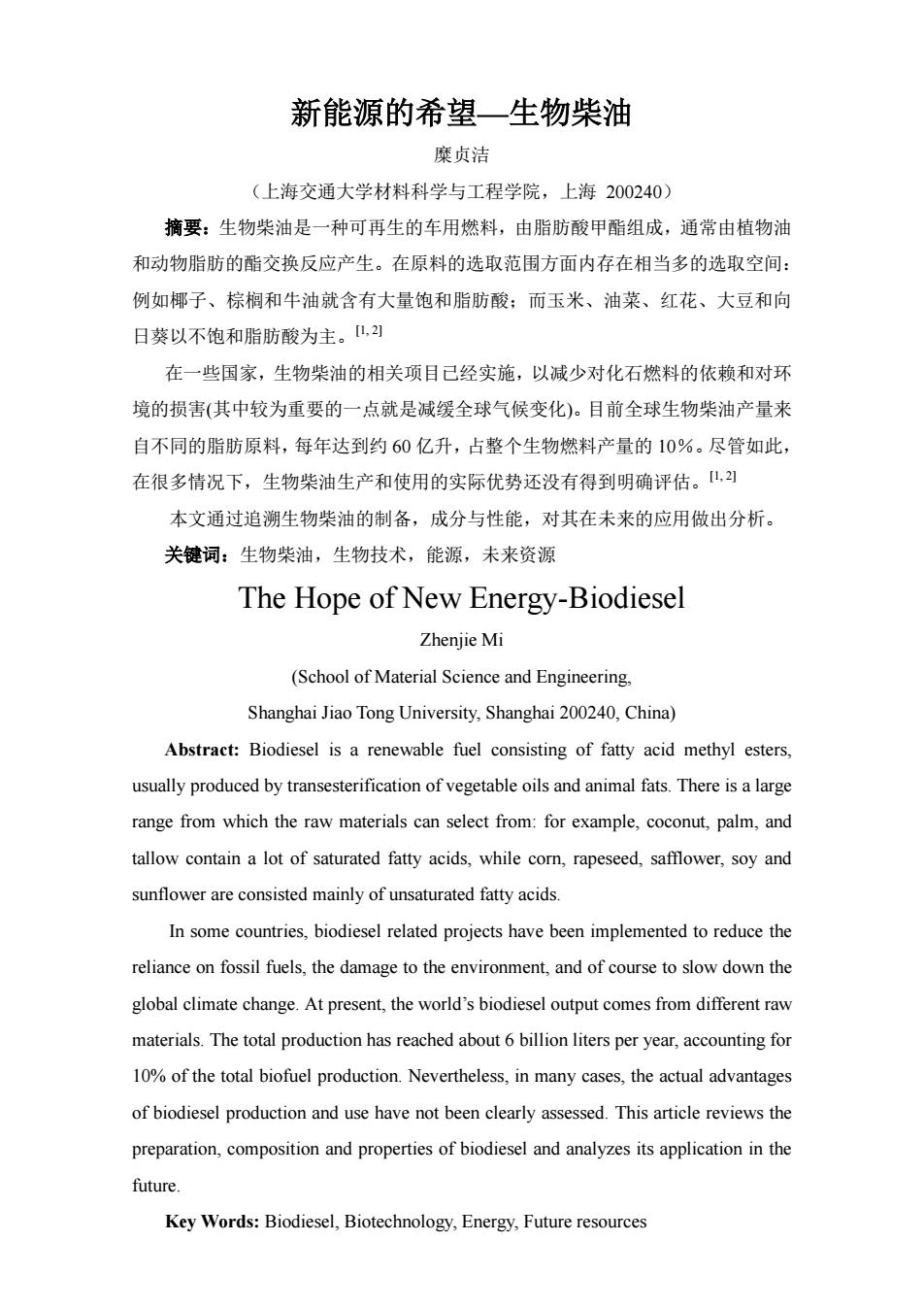正在加载图片...

新能源的希望一生物柴油 糜贞洁 (上海交通大学材料科学与工程学院,上海200240) 摘要:生物柴油是一种可再生的车用燃料,由脂肪酸甲酯组成,通常由植物油 和动物脂肪的酯交换反应产生。在原料的选取范围方面内存在相当多的选取空间: 例如椰子、棕榈和牛油就含有大量饱和脂肪酸;而玉米、油菜、红花、大豆和向 日葵以不饱和脂肪酸为主。山2) 在一些国家,生物柴油的相关项目己经实施,以减少对化石燃料的依赖和对环 境的损害(其中较为重要的一点就是减缓全球气候变化)。目前全球生物柴油产量来 自不同的脂肪原料,每年达到约60亿升,占整个生物燃料产量的10%。尽管如此, 在很多情况下,生物柴油生产和使用的实际优势还没有得到明确评估。山,) 本文通过追溯生物柴油的制备,成分与性能,对其在未来的应用做出分析。 关键词:生物柴油,生物技术,能源,未来资源 The Hope of New Energy-Biodiesel Zhenjie Mi (School of Material Science and Engineering, Shanghai Jiao Tong University,Shanghai 200240,China) Abstract:Biodiesel is a renewable fuel consisting of fatty acid methyl esters, usually produced by transesterification of vegetable oils and animal fats.There is a large range from which the raw materials can select from:for example,coconut,palm,and tallow contain a lot of saturated fatty acids,while corn,rapeseed,safflower,soy and sunflower are consisted mainly of unsaturated fatty acids. In some countries,biodiesel related projects have been implemented to reduce the reliance on fossil fuels,the damage to the environment,and of course to slow down the global climate change.At present,the world's biodiesel output comes from different raw materials.The total production has reached about 6 billion liters per year,accounting for 10%of the total biofuel production.Nevertheless,in many cases,the actual advantages of biodiesel production and use have not been clearly assessed.This article reviews the preparation,composition and properties of biodiesel and analyzes its application in the future Key Words:Biodiesel,Biotechnology,Energy,Future resources新能源的希望—生物柴油 糜贞洁 (上海交通大学材料科学与工程学院,上海 200240) 摘要:生物柴油是一种可再生的车用燃料,由脂肪酸甲酯组成,通常由植物油 和动物脂肪的酯交换反应产生。在原料的选取范围方面内存在相当多的选取空间: 例如椰子、棕榈和牛油就含有大量饱和脂肪酸;而玉米、油菜、红花、大豆和向 日葵以不饱和脂肪酸为主。[1, 2] 在一些国家,生物柴油的相关项目已经实施,以减少对化石燃料的依赖和对环 境的损害(其中较为重要的一点就是减缓全球气候变化)。目前全球生物柴油产量来 自不同的脂肪原料,每年达到约 60 亿升,占整个生物燃料产量的 10%。尽管如此, 在很多情况下,生物柴油生产和使用的实际优势还没有得到明确评估。[1, 2] 本文通过追溯生物柴油的制备,成分与性能,对其在未来的应用做出分析。 关键词:生物柴油,生物技术,能源,未来资源 The Hope of New Energy-Biodiesel Zhenjie Mi (School of Material Science and Engineering, Shanghai Jiao Tong University, Shanghai 200240, China) Abstract: Biodiesel is a renewable fuel consisting of fatty acid methyl esters, usually produced by transesterification of vegetable oils and animal fats. There is a large range from which the raw materials can select from: for example, coconut, palm, and tallow contain a lot of saturated fatty acids, while corn, rapeseed, safflower, soy and sunflower are consisted mainly of unsaturated fatty acids. In some countries, biodiesel related projects have been implemented to reduce the reliance on fossil fuels, the damage to the environment, and of course to slow down the global climate change. At present, the world’s biodiesel output comes from different raw materials. The total production has reached about 6 billion liters per year, accounting for 10% of the total biofuel production. Nevertheless, in many cases, the actual advantages of biodiesel production and use have not been clearly assessed. This article reviews the preparation, composition and properties of biodiesel and analyzes its application in the future. Key Words: Biodiesel, Biotechnology, Energy, Future resources